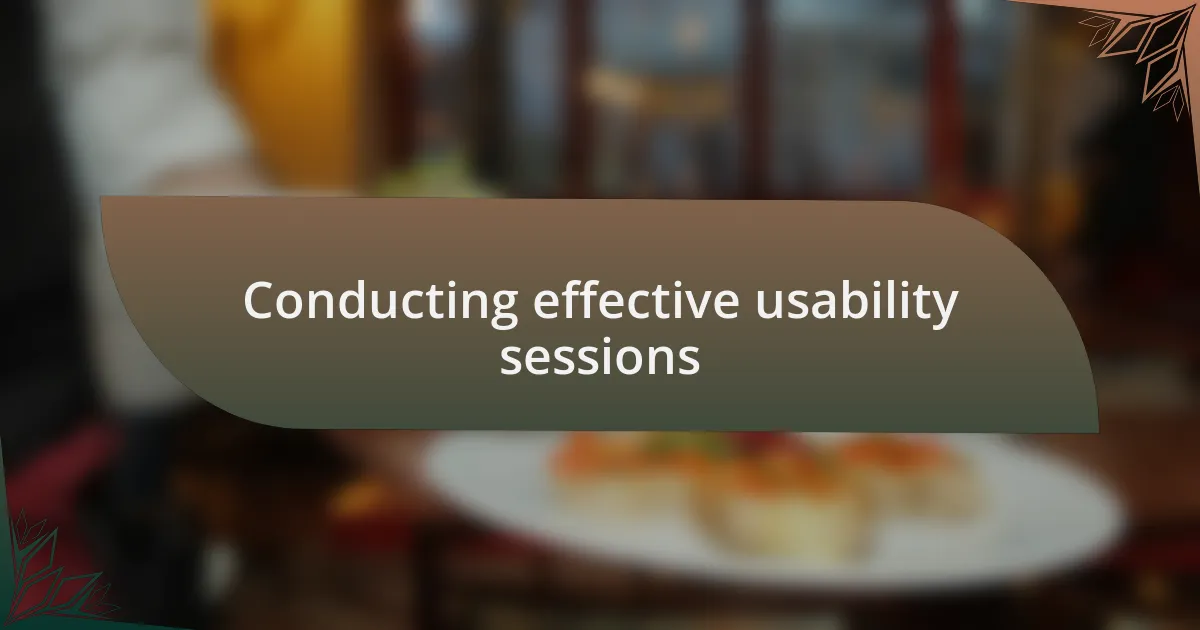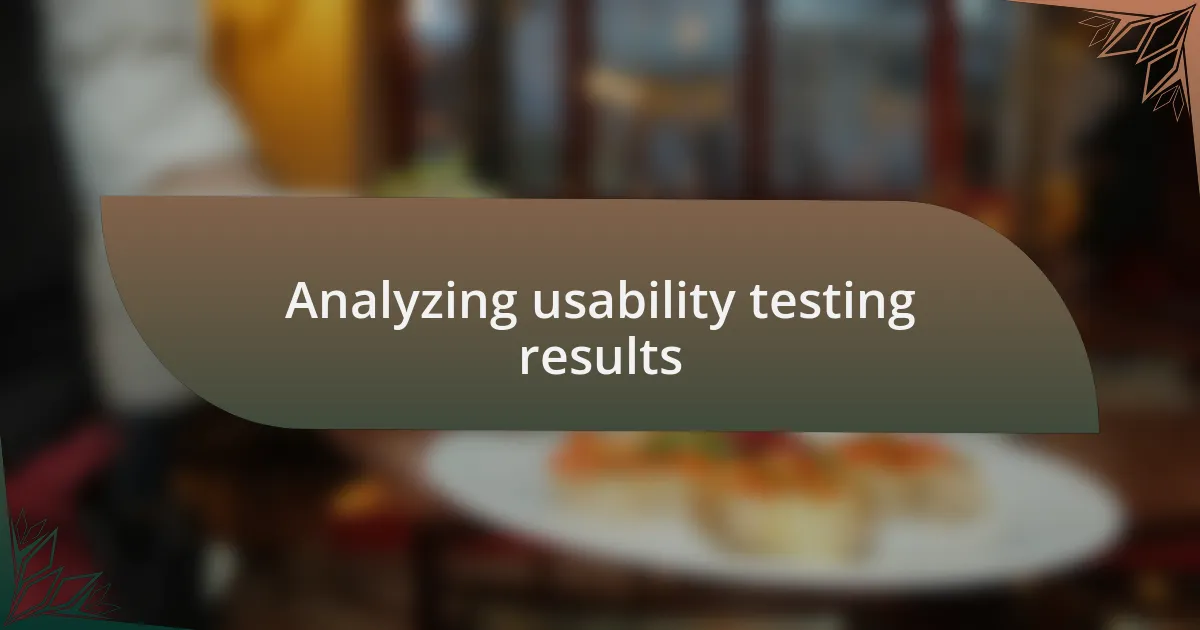Key takeaways:
- Usability testing reveals how users engage with a design, highlighting the importance of visual cues and emotional responses in enhancing user experience.
- Feedback from real users is crucial, as it can lead to significant design improvements and better navigation understanding.
- Establishing rapport and asking open-ended questions during sessions fosters openness and uncovers deeper insights into user interactions.
- Analyzing results involves identifying patterns in user feedback and being flexible in design approaches to align with user needs.

Understanding usability testing
Usability testing is all about understanding how real users interact with a website. I remember the first time I watched someone struggle with a form on a site I had designed; it was an eye-opener for me. Seeing their frustration made me realize that even small design elements can significantly impact user experience.
When I conduct usability testing, I always ask myself, “Are we truly creating a space where users feel comfortable navigating?” This question drives my approach, pushing me to focus on simplifying the user journey. Each test session reveals something new, and often, it’s the users’ emotional responses that steer the direction of the design process.
One memorable instance was when a user hesitated to click a button because it blended too much with the background. The moment highlighted how crucial visual cues are in guiding users. It’s a reminder that usability testing isn’t just about functionality; it’s also about creating an emotional connection that makes users feel confident and engaged.

Importance of usability testing
The importance of usability testing cannot be overstated. I vividly remember a project where I assumed the navigation was intuitive, only to discover during testing that users felt lost. Their confusion was palpable, which was a humbling reminder that what seems clear to us as designers may not be to the end-user.
Every usability test I conduct uncovers insights that directly inform my design choices. For instance, one time a user expressed uncertainty about how to return to the homepage. That comment led to a redesign of the navigation, ensuring it was not only visible but also intuitively understood by everyone. How often do we overlook these simple, yet critical, aspects?
Feedback from users is invaluable. It’s fascinating to witness how a small tweak can elevate the overall user experience. One instance stands out: after adjusting a color scheme based on user feedback, I saw an immediate boost in engagement metrics. It’s moments like these that reinforce my belief in the power of usability testing—it’s not just a task, but a pivotal element of creating successful designs.

Key steps in usability testing
When it comes to usability testing, the first step I always emphasize is defining clear goals for the test. For instance, in one of my projects, I set out to evaluate the checkout process. By focusing specifically on that journey, I was able to gather targeted insights that truly reflected users’ experiences, rather than vague impressions. Have you ever approached a test without a clear focus? I can tell you, it can lead to scattered results that miss the mark.
Next, recruiting the right participants is crucial. I once worked with a client that wanted feedback from their target demographic, but we ended up testing with people whose needs didn’t align at all. The feedback was misleading and didn’t lead us to any meaningful design changes. This experience taught me that having the right users in your testing sessions can make all the difference in obtaining actionable insights.
As the testing unfolds, I’m always keen on observing user interactions directly. I remember watching a user struggle to find the search function, even though it was placed prominently on the page. Their frustration felt palpable. This moment reminded me of the importance of not just collecting feedback through surveys or interviews but truly witnessing how users navigate the site. Isn’t it fascinating how our own perceptions can sometimes blind us to the real issues at hand?

Preparing for usability testing
Preparing for usability testing starts with gathering all relevant materials. I vividly recall one instance where I created a usability test script that included specific tasks for participants to complete. Having a well-structured script not only outlined the objectives but also guided the session smoothly, preventing unnecessary tangents. Have you ever tried to facilitate a discussion without a roadmap? It can often leave both you and the participants feeling lost.
Another critical aspect is ensuring the testing environment is set up appropriately. I once conducted a test in a noisy café, which proved distracting for participants. The background chatter made it difficult for them to concentrate and contribute feedback effectively. If there’s one lesson I’ve learned, it’s that a quiet and comfortable setting can significantly influence the quality of the insights gathered during testing.
Finally, I always remind myself to prepare for technical aspects beforehand. During one testing session, a minor glitch in the demo version caused unnecessary delays. I can’t stress enough how essential it is to troubleshoot the technology before diving into user interactions. Isn’t it frustrating when tech issues derail valuable feedback? Being proactive about these details can save time and enhance the overall testing experience.

Conducting effective usability sessions
When conducting effective usability sessions, I find that one of the most powerful approaches is to establish rapport with participants right from the start. In a recent session, I shared a brief personal story about my own web design challenges, which helped participants relax and feel comfortable expressing their thoughts. It’s surprising how a little vulnerability can foster openness. Have you ever noticed how a friendly atmosphere invites more genuine feedback?
Another key element is to ask open-ended questions during the session. For example, instead of simply inquiring whether they liked a design element, I might ask, “What feelings does this design evoke for you?” This technique not only uncovers deep insights but also encourages participants to think critically about their interactions. I’ve seen firsthand how shifting the focus from surface-level preferences to emotional responses results in richer, more valuable feedback. How often do we miss out on these insights by sticking to basic queries?
Lastly, taking notes during the session is essential, but I also pay attention to non-verbal cues. During a recent test, I noticed a participant’s furrowed brow when encountering a confusing navigation element, which prompted me to explore their experience in depth. Recognizing these subtle signs can lead to discoveries that discussions alone might overlook. Don’t you think that sometimes the unspoken words tell us just as much, if not more, than what’s actually said?

Analyzing usability testing results
Analyzing the usability testing results is where the real learning begins. After each session, I meticulously review the notes and recordings, highlighting key moments that stood out. One time, I observed a participant struggling to complete a task due to unclear labeling on buttons. This stuck with me—how often do we overlook the importance of clarity in design? It made me wonder what other simple changes could make a significant impact on user experience.
I also categorize feedback into themes, looking for patterns that repeat across different participants. In one study, several users expressed frustration with a particular layout. It struck me how consistent user struggles could reveal underlying issues that demand immediate attention. Isn’t it fascinating how collective observations can guide us towards meaningful improvements?
Lastly, I take a reflective approach when considering how the findings align with my original design goals. Sometimes, I realize that my vision needs adjustment based on real user interactions. For instance, I once had to rethink a navigation structure entirely after testing revealed users felt lost. Have you ever faced a moment where you had to overhaul your initial ideas based on feedback? Embracing flexibility can lead to a more user-centric design and ultimately create a better experience for everyone.

Lessons learned from my testing
One of the most eye-opening lessons I learned during my usability testing was the power of feedback in sparking a creative mindset. I still remember a session where a participant pointed out a feature I thought was intuitive, but they completely missed it. Their struggle made me reconsider how I was framing certain elements. Could it be that I was too close to the design to see its flaws? This experience taught me the importance of stepping back and viewing the design through the user’s lens, reminding me that my assumptions don’t always align with user realities.
I also discovered that emotional responses can greatly influence usability. During a test, I witnessed a user visibly frustrated, grappling with a complex form submission process. Their body language spoke volumes, as they sighed heavily, which brought a sense of urgency to address this issue. Have you ever felt that frustration as a user? It struck me that making processes straightforward and user-friendly can transform that frustration into satisfaction. This insight made me prioritize ease of interaction in my design revisions, leading to a more empathetic approach.
Lastly, I realized the importance of creating an inviting atmosphere during testing sessions. In one instance, I offered a participant a warm beverage before we began, and it seemed to ease their nerves. The difference in their willingness to openly share thoughts was remarkable. I began to think about how small gestures can significantly affect user engagement. Why not foster an environment that encourages candidness and openness? Building rapport during these tests turned out to be a game changer, guiding the quality of insights I received.